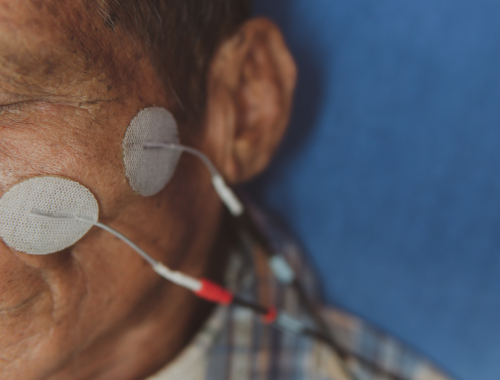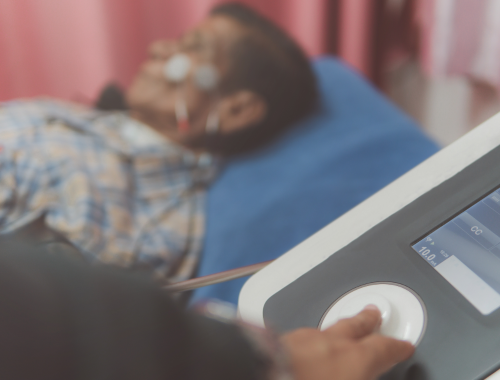Difference Between Central and Peripheral Facial Nerve Palsy
Central facial palsy occurs when the lesion or damage is in the brain. It results in paralysis in the lower half of one side of the face. Peripheral facial palsy results in total paralysis of one-half of the face. Bell’s palsy is an example of peripheral facial palsy.

What is central facial palsy?
Definition:
Central facial palsy occurs when the lesion or damage is in the brain. It results in paralysis in the lower half of one side of the face.
Causes:
Central facial nerve palsy is caused by stroke and brain tumors.
Symptoms:
Central facial palsy causes hemiparesis of opposite side muscles of facial expression. Forehead muscles and muscles closing the eyelid are unaffected. Functions like talking and swallowing are impaired.
Diagnosis:
Techniques like transcranial magnetic stimulation and MRI scan are used to diagnose central facial nerve palsy.
Treatment:
Treatment for central facial nerve palsy is electromyographic biofeedback that generates electrical potentials for the affected muscles to stimulate them to work.

What is peripheral facial nerve palsy?
Definition:
Peripheral facial palsy results in total paralysis of one-half of the face. Bell’s palsy is an example of peripheral facial palsy.
Causes:
Upper motor neuron causes of peripheral facial palsy are stroke, brain tumors, multiple sclerosis, syphilis, HIV, and intracranial hemorrhage. Lower motor neuron causes of peripheral facial nerve palsy are Bell’s palsy, acoustic neuroma, Ramsey Hunt syndrome, Lyme disease, and trauma.
Symptoms:
Symptoms of peripheral facial nerve palsy are inability to close the eye, dry eye, drooping of the angle of the mouth, inability to smile, and move lips.
Diagnosis:
Diagnosis of peripheral facial palsy is confirmed after investigations like CT scan, MRI scan, electromyography (EMG), and nerve conduction studies are carried out.
Treatment:
For Bell’s palsy, the treatment choice is steroids which is prednisolone. Other treatment options include surgical resection of the tumors, physiotherapy, and facial exercises.
Difference between central and peripheral facial nerve palsy
Definition:
Central facial palsy occurs when the lesion or damage is in the brain. It results in paralysis in the lower half of one side of the face. Peripheral facial palsy results in total paralysis of one-half of the face. Bell’s palsy is an example of peripheral facial palsy.
Causes:
Central facial nerve palsy is caused by stroke and brain tumors. Upper motor neuron causes of peripheral facial palsy are stroke, brain tumors, multiple sclerosis, syphilis, HIV, and intracranial hemorrhage. Lower motor neuron causes of peripheral facial nerve palsy are Bell’s palsy, acoustic neuroma, Ramsey Hunt syndrome, Lyme disease, and trauma.
Symptoms:
Central facial palsy causes hemiparesis of opposite side muscles of facial expression. Forehead muscles and muscles closing the eyelid are unaffected. Functions like talking and swallowing are impaired. Symptoms of peripheral facial nerve palsy are inability to close the eye, dry eye, drooping of the angle of the mouth, inability to smile, and move lips.
Diagnosis:
Techniques like transcranial magnetic stimulation and MRI scan are used to diagnose central facial nerve palsy. Diagnosis of peripheral facial palsy is confirmed after investigations like CT scan, MRI scan, electromyography (EMG), and nerve conduction studies are carried out.
Treatment:
Treatment for central facial nerve palsy is electromyographic biofeedback that generates electrical potentials for the affected muscles to stimulate them to work. For Bell’s palsy, the treatment choice is steroids which is prednisolone. Other treatment options include surgical resection of the tumors, physiotherapy, and facial exercises.
Table of differences between central and peripheral facial nerve palsy

FAQs
How to differentiate central and peripheral facial nerve palsy?
Central facial palsy results in paralysis in the lower half of one side of the face. Peripheral facial palsy results in total paralysis of one-half of the face. Bell’s palsy is an example of peripheral facial palsy.
What is central or peripheral facial nerve palsy?
Central facial palsy occurs when the lesion or damage is in the brain. It results in paralysis in the lower half of one side of the face. Peripheral facial palsy results in total paralysis of one-half of the face. Bell’s palsy is an example of peripheral facial palsy.
Is peripheral facial nerve palsy the same as Bell’s palsy?
Bell’s palsy is the most common type of peripheral facial nerve palsy.
What is the main difference between Bell’s palsy and facial palsy?
Bell’s palsy is the most common type of peripheral facial nerve palsy that results in total paralysis of one-half of the face. Facial palsy is a broad term that can be central or peripheral.
What are the clinical features of peripheral facial palsy?
Peripheral facial palsy results in total paralysis of one-half of the face.
What are the symptoms of peripheral nerve palsy?
Symptoms of peripheral facial nerve palsy are inability to close the eye, dry eye, drooping of the angle of the mouth, inability to smile, and move lips.
- Differences Between Reptiles and Amphibians - May 17, 2024
- Difference Between Ophthalmology and Optometry - May 15, 2024
- Difference Between Fear and Anxiety - April 2, 2024
Search DifferenceBetween.net :
Leave a Response
References :
[0]Garro, Aris, and Lise E. Nigrovic. "Managing peripheral facial palsy." Annals of emergency medicine 71.5 (2018): 618-624.
[1]Fabricius, Jesper, Simple F. Kothari, and Mohit Kothari. "Assessment and rehabilitation interventions for central facial palsy in patients with acquired brain injury: a systematic review." Brain injury 35.5 (2021): 511-519.
[2]Cattaneo, Luigi, et al. "Central facial palsy revisited: A clinical‐radiological study." Annals of neurology 68.3 (2010): 404-408.
